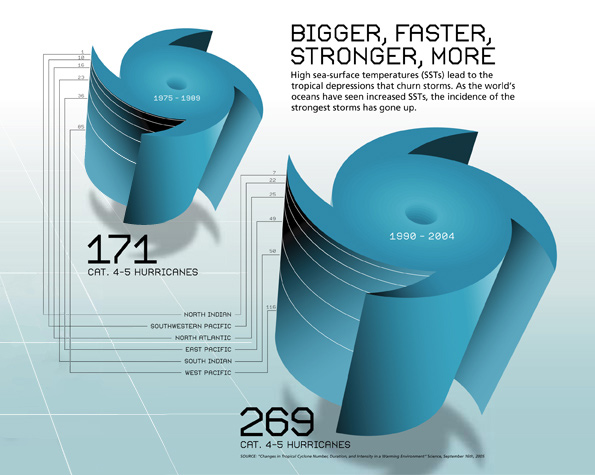Teaching:TUW - UE InfoVis WS 2006/07 - Gruppe 03 - Aufgabe 2: Difference between revisions
Jump to navigation
Jump to search
m (→.....) |
(→.....) |
||
| Line 45: | Line 45: | ||
*The graphic isn't very comparative. The smaler "3D Hurricane" appears to be just farther behind in time and position. | *The graphic isn't very comparative. The smaler "3D Hurricane" appears to be just farther behind in time and position. | ||
*Graphical elegance is often found in simplicity of design and complexity of data, but in this graphic the graphical design is more complex than the visualised data. | *Graphical elegance is often found in simplicity of design and complexity of data, but in this graphic the graphical design is more complex than the visualised data. | ||
*In the text a reason for increased hurricans is mentioned, but in the shown data is no evidence for that, because there is no | *In the text a reason for increased hurricans is mentioned, but in the shown data is no evidence for that, because there is no related data. | ||
*The word "category" is not spelt out. | *The word "category" is not spelt out. | ||
| Line 54: | Line 54: | ||
*efficent in interpretation? | *efficent in interpretation? | ||
*often narrative in content, showing shifts in the relationship between variables as the index variable change | *often narrative in content, showing shifts in the relationship between variables as the index variable change | ||
*the data is wrong, the sum of the hurricans(171) as shown in the left graphic does not equal the summed up hurricans from the regions(160) shown in the same graphic. | |||
==improved graphic== | ==improved graphic== | ||
Revision as of 23:29, 12 November 2006
Poor Graphic

Arguments why it is a poor graphic
Principles of Graphical Integrity
- Lie Factor: The right graphic seems do be much larger then the left. It should be only 1,5 times larger then the other one based on the data. The size of the effect in data is 5,7% and the effect in the graphic about 1,55%, which results a high Lie Factor of 2,97.(BIN MIR NICHT SICHER) Its Lie Factor should have a value between 0.95 and 1.05. [Friendly, 2005]
- the numbers are not readable and the lines between the numbers are not needed and very irritating.
- a pseudo 3-dimensional graphic is used to show 1-dimensional data
Data-Ink Ratio
This graph has a low Data-Ink Ratio. To maximise the data-ink ratio we have to reduce the non-data ink and enhance the data ink.
How much of the ink could be removed without loss of information?
- A large share of ink is used to show the pseudo 3-dimensional graphic and their shadows.
- The white lines forming squares (left) do not contain additional information.
- It's not necessary to wirte two times "CAT. 4-5 Hurricanes".
Missing ink
- The ink don't change as the data change.
Visual Clutter
Data Density
The Data Density of this graphic is very low. We should maximise it and the size of the data matrix, within reason.
- The graphic is very big and should be shrunk way down.
Chartjunk
.....
- The graphic isn't very comparative. The smaler "3D Hurricane" appears to be just farther behind in time and position.
- Graphical elegance is often found in simplicity of design and complexity of data, but in this graphic the graphical design is more complex than the visualised data.
- In the text a reason for increased hurricans is mentioned, but in the shown data is no evidence for that, because there is no related data.
- The word "category" is not spelt out.
- multivariate
- efficent in interpretation?
- often narrative in content, showing shifts in the relationship between variables as the index variable change
- the data is wrong, the sum of the hurricans(171) as shown in the left graphic does not equal the summed up hurricans from the regions(160) shown in the same graphic.
improved graphic
description of improvements
References
[Friendly, 2005] Michael Friendly, The Lie Factor, Department of Mathematics and Statistics, Toronto, Last updated: February 23, 2002, Retrieved at: Nov 17, 2006, http://www.math.yorku.ca/SCS/Gallery/lie-factor.html